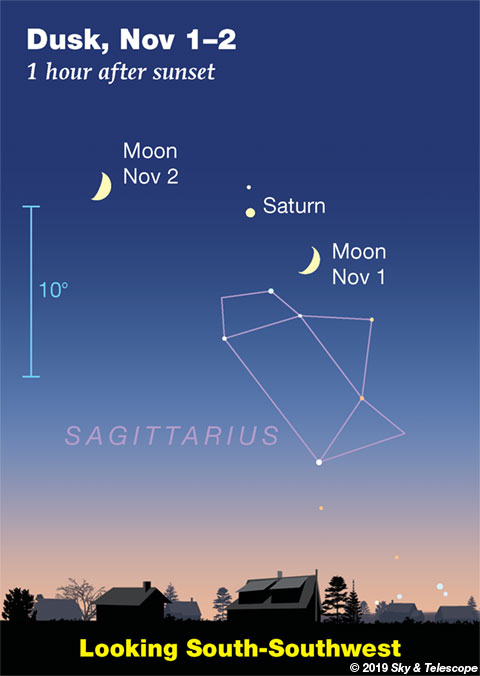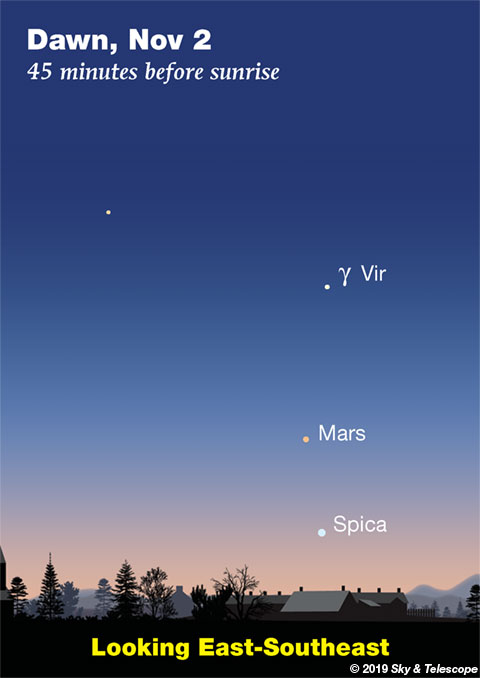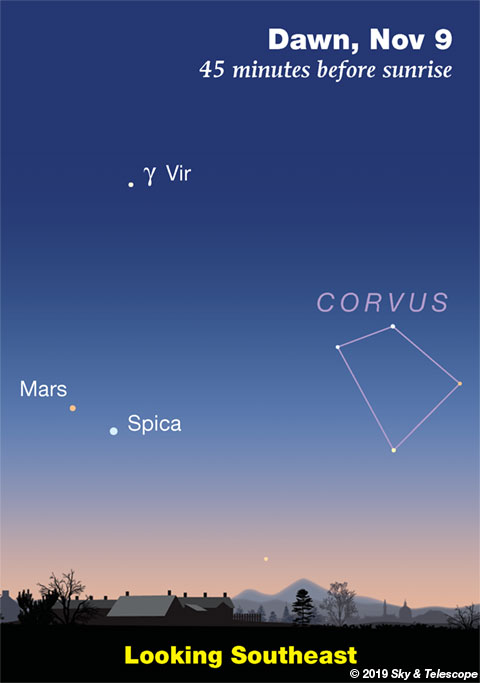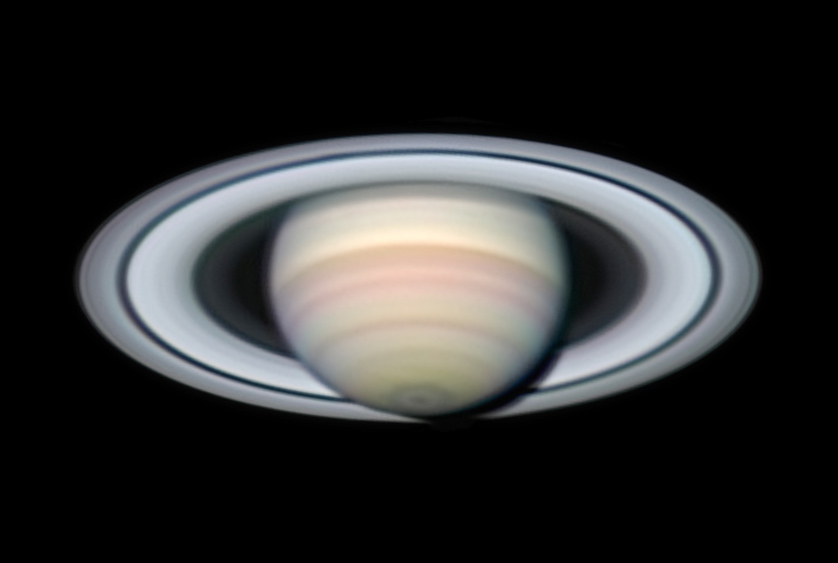


Friday, Nov. 1
• The waxing crescent Moon shines in the south-southwest at dusk, with Saturn glowing 4° or 5° to its upper left (for North America) as shown here.
Look much farther lower right, by nearly 20°, for Jupiter.
Saturday, Nov. 2
• Saturn shines right of the Moon in early evening, as shown here. Look much higher above them for Altair, a little brighter than Saturn.
• Capella sparkles low in the northeast these evenings. Look for the Pleiades cluster, fingertip-size, about three fists at arm's length to Capella's right. These harbingers of the cold months rise higher as evening grows late.
Upper right of Capella, and upper left of the Pleiades, the stars of Perseus lie astride the Milky Way.
• Standard time resumes at 2 a.m. Sunday morning for most of North America. Clocks fall back an hour. And for astronomers, darkness henceforth arrives an hour earlier!
Sunday, Nov. 3
• First-quarter Moon (exactly so at 5:23 a.m. Monday morning EST). On Sunday evening the Moon shines inside the huge triangle of Saturn to its lower right, Altair much higher to its upper right, and Fomalhaut way off to the Moon's left.
• Sometime around 10 p.m., depending on where you live, zero-magnitude Capella will have risen exactly as high in the northeast as zero-magnitude Vega has sunk in the west-northwest. How accurately can you time this event? Astrolabe not required. . . but it would help.
Monday, Nov. 4
• The Moon this evening is almost as close to first quarter as it was yesterday evening. You'll find that the Moon is nearly in line with Fomalhaut, about two fists to its lower left, and Altair, three or four fists to its upper right.
Tuesday, Nov. 5
• Fomalhaut is lower left of the Moon this evening, by almost two fists. Look for Diphda (Beta Ceti) two or three fists left of Fomalhaut.
Very high in the southeast now is the Great Square of Pegasus. Its western side points down nearly to 1st-magnitude Fomalhaut. It's eastern side points down, a little more askew, toward 2nd-magnitude Diphda.
Wednesday, Nov. 6
• Now the waxing gibbous Moon stands on the line from the western side of the Great Square of Pegasus down to Fomalhaut.
Thursday, Nov. 7
• Vega is the brightest star high in the west. Almost as high in the southwest (depending on your latitude) is Altair, not quite as bright.
Just right or upper right of Altair, by a finger-width at arm's length, is orange Tarazed, looking like Altair's little sidekick but actually a much bigger and brighter star far in the background. Altair is 17 light-years away. Tarazed is about 360 light-years away, and it's 100 times as luminous!
Friday, Nov. 8
• Now the gibbous Moon stands on the line from the eastern side of the Great Square of Pegasus down to Diphda.
• By about 9 p.m. wintry Orion is clearing the eastern horizon (depending on how far east or west you live in your time zone). High above Orion shines orange Aldebaran. Above Aldebaran is the little Pleiades cluster, the size of your fingertip at arm's length.
Far left of Aldebaran and the Pleiades shines bright Capella.
Saturday, Nov. 9
• In early evening, look high above the Moon for the Great Square of Pegasus through the moonlight. It's standing on one corner. The line from its top star through its bottom star points to the Moon.
• Transit of Mercury coming up November 11. Mercury will cross the face of the Sun during morning in North America, midday in South America, and afternoon for Europe and Africa. Map and details, or see the November Sky & Telescope, page 48. And see Citizen Science with the Transit of Mercury.
• Happy 85th birthday, Carl Sagan (November 9, 1934 – December 20, 1996). If only.
________________________
Want to become a better astronomer? Learn your way around the constellations. They're the key to locating everything fainter and deeper to hunt with binoculars or a telescope.
This is an outdoor nature hobby. For an easy-to-use constellation guide covering the whole evening sky, use the big monthly map in the center of each issue of Sky & Telescope, the essential guide to astronomy.

Once you get a telescope, to put it to good use you'll need a detailed, large-scale sky atlas (set of charts). The basic standard is the Pocket Sky Atlas (in either the original or Jumbo Edition), which shows stars to magnitude 7.6.
Next up is the larger and deeper Sky Atlas 2000.0, plotting stars to magnitude 8.5; nearly three times as many. The next up, once you know your way around, are the even larger Interstellarum atlas (stars to magnitude 9.5) and Uranometria 2000.0 (stars to magnitude 9.75). And read how to use sky charts with a telescope.
You'll also want a good deep-sky guidebook, such as Sue French's Deep-Sky Wonders collection (which includes its own charts), Sky Atlas 2000.0 Companion by Strong and Sinnott, or the bigger Night Sky Observer's Guide by Kepple and Sanner.
Can a computerized telescope replace charts? Not for beginners, I don't think, and not on mounts and tripods that are less than top-quality mechanically (meaning really heavy and expensive). And as Terence Dickinson and Alan Dyer say in their Backyard Astronomer's Guide, "A full appreciation of the universe cannot come without developing the skills to find things in the sky and understanding how the sky works. This knowledge comes only by spending time under the stars with star maps in hand."
This Week's Planet Roundup
Mercury is out of sight down under Venus.
Venus (magnitude –3.9) is very low in the southwest during bright twilight. Look for it just above the horizon starting about 20 minutes after sunset. Don't confuse it with higher and easier Jupiter, which entices your attention away about 20° to Venus's upper left.
Mars (magnitude +1.8, in Virgo) may be a difficult catch above the east-southeast horizon in early dawn. Don't confuse it with much brighter Arcturus, also orange-ish, twinkling some 30° to Mars's left or upper left.
On the mornings of November 9th, 10th, and 11th, sparkly Spica is passing about 3° to Mars's lower right or right. Spica is distinctly brighter at magnitude 1.0.
Jupiter, magnitude –1.9 in southern Ophiuchus, is the creamy-white dot low in the southwest as twilight fades away. It's between Saturn to its upper left and Venus to its lower right, about 20° from each.

Saturn (magnitude +0.6, in Sagittarius) is the steady yellow "star" in the south-southwest during and after dusk. It's about 20° upper left of Jupiter.
Still below Saturn is the handle of the Sagittarius Teapot, highlighted by 2.0-magnitude Sigma Sagittarii (Nunki). Barely upper right of Saturn is the dimmer, smaller bowl of the Sagittarius Teaspoon.
Uranus (magnitude 5.7, in southern Aries) is just past opposition. It's well up in the east by 8 p.m. standard time and highest in the south around 11.
Neptune (magnitude 7.8, in eastern Aquarius) is high in the southern sky during early evening. See our finder charts for Uranus and Neptune and Bob King's story on observing Neptune.
All descriptions that relate to your horizon — including the words up, down, right, and left — are written for the world's mid-northern latitudes. Descriptions that also depend on longitude (mainly Moon positions) are for North America.
Eastern Daylight Time (EDT) is Universal Time (UT) minus 4 hours. Eastern Standard Time (EST) is UT minus 5 hours.
![]() Audio sky tour. Out under the evening sky with your earbuds in place, listen to Kelly Beatty's monthly podcast tour of the heavens above. It's free.
Audio sky tour. Out under the evening sky with your earbuds in place, listen to Kelly Beatty's monthly podcast tour of the heavens above. It's free.
"The dangers of not thinking clearly are much greater now than ever before. It's not that there's something new in our way of thinking, it's that credulous and confused thinking can be much more lethal in ways it was never before."
— Carl Sagan, 1996
 1
1








Comments
Rod
November 4, 2019 at 6:33 am
mary beth. I enjoyed some excellent stargazing Friday night on 01-Nov as well as solar observing during the day and this weekend (very small sunspots visible reported at spaceweather.com). Some Taurid meteors visible flashing briefly, brightly in Taurus and near the constellation. Other observations like last night - 4 Vesta asteroid using my binoculars (10x50) and 90-mm refractor at 31x. Easy target and near 6.5 apparent magnitude in its location in Taurus. It is moving westward (retrograde) towards Cetus, opposition on the 12th. Some excellent views of the Moon last night near First Quarter using my telescope from 71x to 200x views. On the 01-Nov, excellent views of open clusters in Auriga as well as M1, SNR remnant from 1054 AD, Chinese observations (I used the 10-inch). I hope you are planning to view the Mercury transit on 11-Nov coming up and if yes, be safe when solar observing. Early this morning near 0527 EST, I viewed a bright, polar orbiting satellite in ascending node passing near Capella in Auriga. Almost as bright as the satellite heading towards the North Star 🙂
You must be logged in to post a comment.
You must be logged in to post a comment.